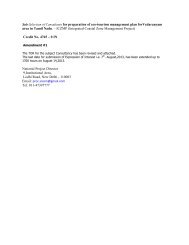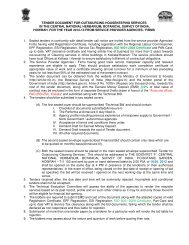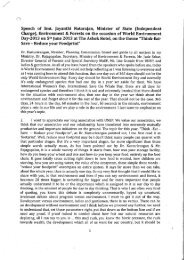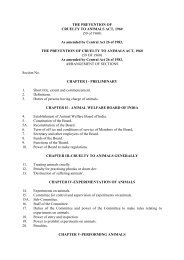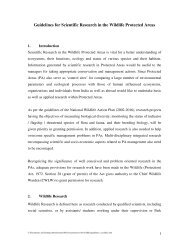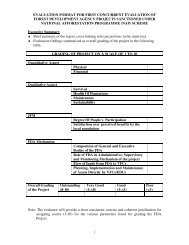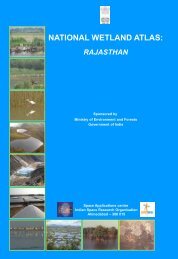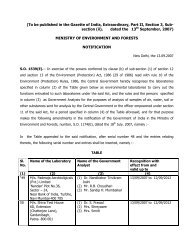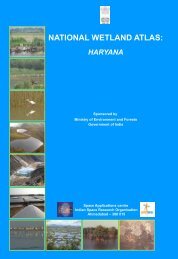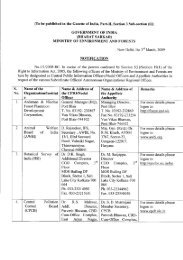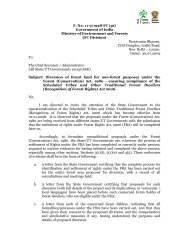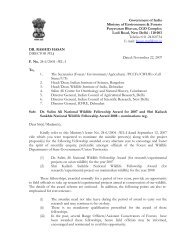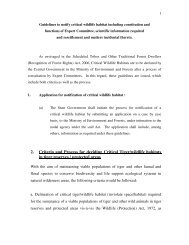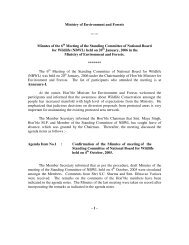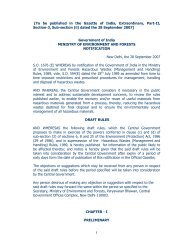Bihar - Ministry of Environment and Forests
Bihar - Ministry of Environment and Forests
Bihar - Ministry of Environment and Forests
- No tags were found...
Create successful ePaper yourself
Turn your PDF publications into a flip-book with our unique Google optimized e-Paper software.
Ground truth data<br />
Remotely sensed data require certain amount <strong>of</strong> field observation called “ground truth” in order to convert it<br />
into meaningful information. Such work involves visiting a number <strong>of</strong> test sites, usually taking the satellite<br />
data. The location <strong>of</strong> the features is recorded using the GPS. The st<strong>and</strong>ard pr<strong>of</strong>orma as per the NWIA manual<br />
was used to record the field data. Field photographs are also taken to record the water quality (subjective),<br />
status <strong>of</strong> aquatic vegetation <strong>and</strong> water spread. All field verification work has been done during October <strong>and</strong><br />
November 2008.<br />
Other data<br />
Survey <strong>of</strong> India topographical maps (SOI) were used for reference purpose. Lineage data <strong>of</strong> National Wetl<strong>and</strong><br />
Maps at 1:250,000 scale was used for reference.<br />
5.0 METHODOLOGY<br />
The methodology to create the state level atlas <strong>of</strong> wetl<strong>and</strong>s is adhered to NWIA technical guidelines <strong>and</strong><br />
procedure manual (Garg <strong>and</strong> Patel, 2007). The overview <strong>of</strong> the steps used is shown in Figure 7. Salient<br />
features <strong>of</strong> methodology adopted are<br />
• Generation <strong>of</strong> spatial framework in GIS environment for database creation <strong>and</strong> organisation.<br />
• Geo-referencing <strong>of</strong> satellite data<br />
• Identification <strong>of</strong> wetl<strong>and</strong> classes as per the classification system given in NWIA Manual <strong>and</strong> mapping <strong>of</strong><br />
the classes using a knowledge based digital classification <strong>and</strong> onscreen interpretation<br />
• Generation <strong>of</strong> base layers (rail, road network, settlements, drainage, administrative boundaries) from<br />
satellite image <strong>and</strong> ancillary data.<br />
• Mosaicing/edge matching to create district <strong>and</strong> state level database.<br />
• Coding <strong>of</strong> the wetl<strong>and</strong>s following the st<strong>and</strong>ard classification system <strong>and</strong> codification as per NWIA<br />
manual.<br />
• Preparation <strong>of</strong> map compositions <strong>and</strong> generation <strong>of</strong> statistics<br />
• Outputs on A3 size prints <strong>and</strong> charts for atlas.<br />
Work was carried out using ERDAS Imagine, Arc/Info <strong>and</strong> Arcgis s<strong>of</strong>twares.<br />
5.1 Creation <strong>of</strong> spatial framework<br />
This is the most important task as the state forms a part <strong>of</strong> the national frame work <strong>and</strong> is covered in multiple<br />
map sheets. To create NWIA database, NNRMS/NRDB st<strong>and</strong>ards is followed <strong>and</strong> four corners <strong>of</strong> the<br />
1:50,000 (15’ x 15’) grids is taken as the tics or registration points to create each map taking master grid as<br />
the reference. Spatial framework details are given in NWIA manual (Garg <strong>and</strong> Patel 2007). The spatial<br />
framework for <strong>Bihar</strong> state is shown in Figure 4.<br />
5.2 Geo-referencing <strong>of</strong> satellite data<br />
In this step the raw satellite images were converted to specific map projection using geometric correction.<br />
This is done using archived geometrically corrected LISS III data (ISRO-NRC-l<strong>and</strong> use / l<strong>and</strong> cover project)<br />
St<strong>and</strong>ard image processing s<strong>of</strong>tware was used for geo-referencing. First one date data was registered with<br />
the archived image. The second date data was then registered with the first date data.<br />
5.3 Mapping <strong>of</strong> wetl<strong>and</strong>s<br />
The delineation <strong>of</strong> wetl<strong>and</strong>s through image analysis forms the foundation for deriving all wetl<strong>and</strong> classes <strong>and</strong><br />
results. Consequently, a great deal <strong>of</strong> emphasis has been placed on the quality <strong>of</strong> the image Interpretation.<br />
In the present study, the mapping <strong>of</strong> wetl<strong>and</strong>s was done following digital classification <strong>and</strong> onscreen visual<br />
interpretation. Wetl<strong>and</strong>s were identified based on vegetation, visible hydrology <strong>and</strong> geography. There are<br />
various methods for extraction <strong>of</strong> water information from remote sensing imagery, which according to the<br />
number <strong>of</strong> b<strong>and</strong>s used, are generally divided into two categories, i.e. Single-b<strong>and</strong> <strong>and</strong> multi-b<strong>and</strong> methods.<br />
Single-b<strong>and</strong> method usually involves choosing a b<strong>and</strong> from multi-spectral image to distinguish water from<br />
l<strong>and</strong> by subjective threshold values. It may lead to over- or under-estimation <strong>of</strong> open water area.<br />
Multi-b<strong>and</strong> method takes advantage <strong>of</strong> reflective differences <strong>of</strong> each b<strong>and</strong>. In this project, five indices known<br />
in literature that enhances various wetl<strong>and</strong> characteristics were used (McFeetres, 1986; Xu Hanqiu, 2006;<br />
Lacaux et al, 2007; Townshend <strong>and</strong> Justice, 1986; Tucker <strong>and</strong> Sellers, 1986) as given below:<br />
i) Normalised Difference Water Index (NDWI) = (Green-NIR) / (Green + NIR)<br />
ii) Modified Normalised Difference Water Index (MNDWI) = (Green-MIR) / (Green + MIR)<br />
iii) Normalised Difference Vegetation Index (NDVI) = (NIR - Red) / (NIR + Red)<br />
iv) Normalised Difference Pond Index (NDPI) = (MIR – Green / MIR + Green)<br />
v) Normalised Difference Turbidity Index (NDTI) = (Red – Green) / (Red + Green)<br />
10



